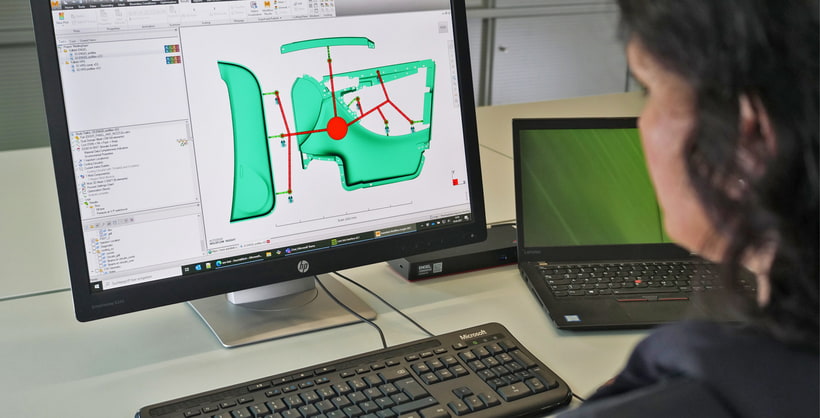Tips for process optimisation in injection moulding
By observing a few points, you can achieve a stable and high performance in the production process. We support you with our tips for process optimisation in injection moulding:
1. Stable processes due to the elimination of melt cushion fluctuation
Weight fluctuations in the melt cushion between the plasticising screw and the mould, can endanger stable processes in the production sequence. Possible weight fluctuations and the overall process can be monitored by controlling the melt cushion. Unsuitable process settings – such as an insufficient holding pressure level or time – or wear on the plasticising screw are the most frequent causes of melt cushion fluctuations.
This is how you can resolve melt cushion fluctuation:
- Decompression after plasticising should be set to between 2 and 15% of the screw diameter, depending on the type of non-return valve.
- Check the non-return valve, screw and plasticising barrel for possible signs of wear.
- Check the closing behaviour of the non-return valve; the closing behaviour can be improved by adjusting the decompression after plasticising.
- Melt cushion fluctuation can be eliminated by using a plasticising unit that exactly matches the material.
- If you notice feeding problems during plasticising, the barrel heating temperature must be adjusted to avoid bridging during material intake.
What makes identifying the causes of problems difficult, is the wide variety of potential influencing factors. In this blog post, I am sharing with you some of my top tips for process optimisation in injection moulding that have secured the greatest success in my 20 years as an application engineer.

2. Optimised quality thanks to complete moulded part filling
This section contains tips for process optimisation in injection moulding that relate to the optimisation of incompletely filled parts. This refers to injection moulded parts whose outer contours are not completely formed. Incompletely filled parts are injection moulded parts whose outer contours are not completely formed. This issue occurs particularly frequently with long flow paths or in thin-walled areas (for example ribs). If mould venting is inadequate, the problem can also occur at other locations.
- Check that the injected plastic volume (for example, the shot volume) is not too low in relation to the parts weight.
- Make sure that the injection pressure and injection speed of the injection moulding machine are sufficient and that there is a residual melt cushion.
- The use of digital solutions from the ENGEL iQ product family makes it possible to increase part repeatability and compensate for various process fluctuations.
3. Short cycle times for improved productivity and cost efficiency
The primary goal of our customers is always to strive for low cycle times. To do so, we recommend regularly checking whether it is necessary to set maximum values for process stability. This is because maximum settings mean a correspondingly higher use of energy and place a greater load on the wear parts. Maximum values are always useful if the cycle time can be significantly reduced as a result.
With these tips for process optimisation in injection moulding, you can produce more efficiently and save costs:
- Work with parallel motion to shorten the cycle time – simultaneous or synchronised movements save time: for example, you can start the peripheral solutions while the mould is still opening.
- Check the mould opening strokes and set mould opening to the required minimum.
- Use the entire cooling time for the plasticising process to ensure gentle processing of the material and minimise wear.
- Reduce the screw speed during melt preparation – the energy requirements and material stress are also greater at higher speeds.
Do you need more support from our
application engineering experts to
optimise your injection moulding processes?
More about our products from the article
Process analysis and optimisation service
If you need assistance, our Application Engineering Support team will be happy to help you with your optimisation projects.
Increase process stability
Discover more about the smart solutions from the iQ product family for more process stability.















